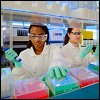|
||||||||||

HORMONE STANDARDIZATION
 Steroid hormones, especially testosterone and estradiol, regulate and affect a wide range of body functions including growth and development, control of metabolic pathways, and the use and storage of energy. Thus, testing for steroid hormones has become an important tool in the research and management of hormone-related diseases and disorders.
Steroid hormones, especially testosterone and estradiol, regulate and affect a wide range of body functions including growth and development, control of metabolic pathways, and the use and storage of energy. Thus, testing for steroid hormones has become an important tool in the research and management of hormone-related diseases and disorders.
Numerous scientific publications, clinical guidelines, and recommendations reflect the wide use of measurements of testosterone and estradiol in clinical research and patient care. At the same time, problems in the performance of these tests hamper their broad and effective implementation and the translation of research findings into information useful for patient care, such as in new evidence-based clinical guidelines. To overcome this challenge, the clinical and research community has stated the need for standardization of testosterone and estradiol tests.
In 2007, the Division of Laboratory Sciences, National Center for Environmental Health, Centers for Disease Control and Prevention (CDC) responded to this need by starting a project to standardize these tests. As part of this effort, CDC is working with researchers to develop and implement the technical components needed for standardization and has partnered with professional organizations, such The Endocrine Society, to help translate and disseminate information on testosterone and estradiol testing and interpretation to the clinical and research community.
CDC Workshop Report
Improving Steroid Hormone Measurements in Patient Care and Research Translation
The Division of Laboratory Sciences (DLS) at the Centers for Disease Control and Prevention (CDC) convened a workshop on March 17-18, 2008 to discuss current needs and problems in steroid hormone testing, with special focus on testosterone and estradiol, and to discuss CDC's activities to improve and standardize measurements obtained with steroid hormone tests. The workshop aimed to engage participants involved in steroid hormone testing to provide their insight and experiences and to discuss cross-cutting perspectives.
More than 60 experts from the research and clinical community, industry, assay manufacturers, and government attended the workshop. The Endocrine Society, American Society of Clinical Endocrinologists, American Association of Clinical Chemistry, and American Society for Reproductive Medicine were represented.
Thirteen presentations addressed the importance of testosterone and estradiol in research, disease risk assessment, diagnosis, and treatment monitoring. They covered the following areas: hypogonadism and androgen deficiency in men, polycystic ovary syndrome, epidemiology and cancer research, osteoporosis, reproductive health, in-vitro fertilization, and child development. The presentations and discussions addressed the current status and performances of different measurement technologies such as immunoassays, mass spectrometry-based assays and highly sensitive bioassays as well as biological variability, analyte stability and other issues relevant to measurement and result interpretation.
The presenters and workshop participants emphasized that measurement of testosterone and estradiol is highly valuable in assessing disease risk, diagnosing disease, and monitoring treatment, as reflected in may clinical guidelines, recommendations and review articles. All clinical and research applications share the same problems:
These problems profoundly limit progress in disease research and translating valuable research findings into information useful for patient care and disease management as stated in several editorials and research publications. Therefore, standardization of these measurements is greatly needed and efforts led by CDC, similar to those used to standardize cholesterol, were suggested.
Mass spectrometry combined with gas chromatography or high performance liquid chromatography can overcome the limitations observed with immunoassays especially for measurements of testosterone concentrations observed in women and children and of estradiol concentrations observed in postmenopausal women, men, and children.
CDC's steroid hormone standardization project aims to address the stated needs by providing reference laboratory measurements to improve comparability and performance of the assays. CDC is working with professional organizations on increasing awareness to improve the appropriate use of steroid assays and to facilitate interpretation of data obtained with these assays.
For More Information...
Non-Federal Resources